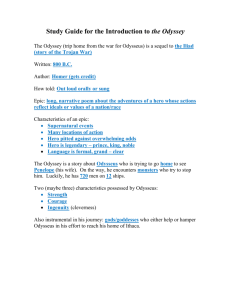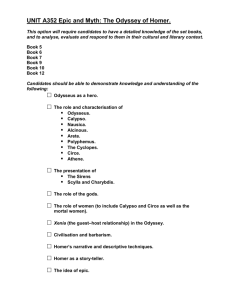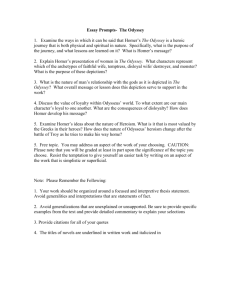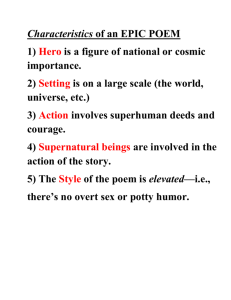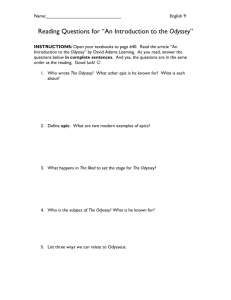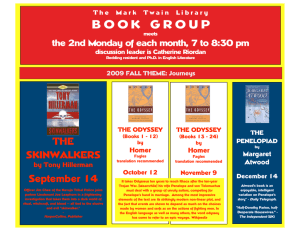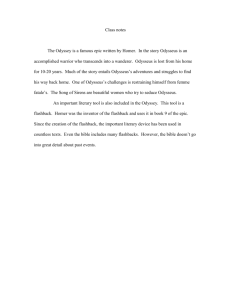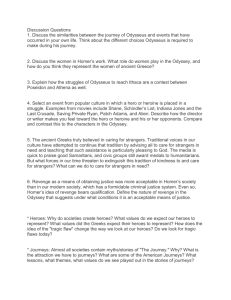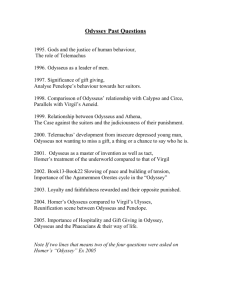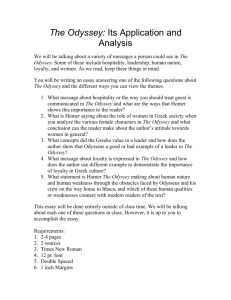Homer's Odyssey
advertisement
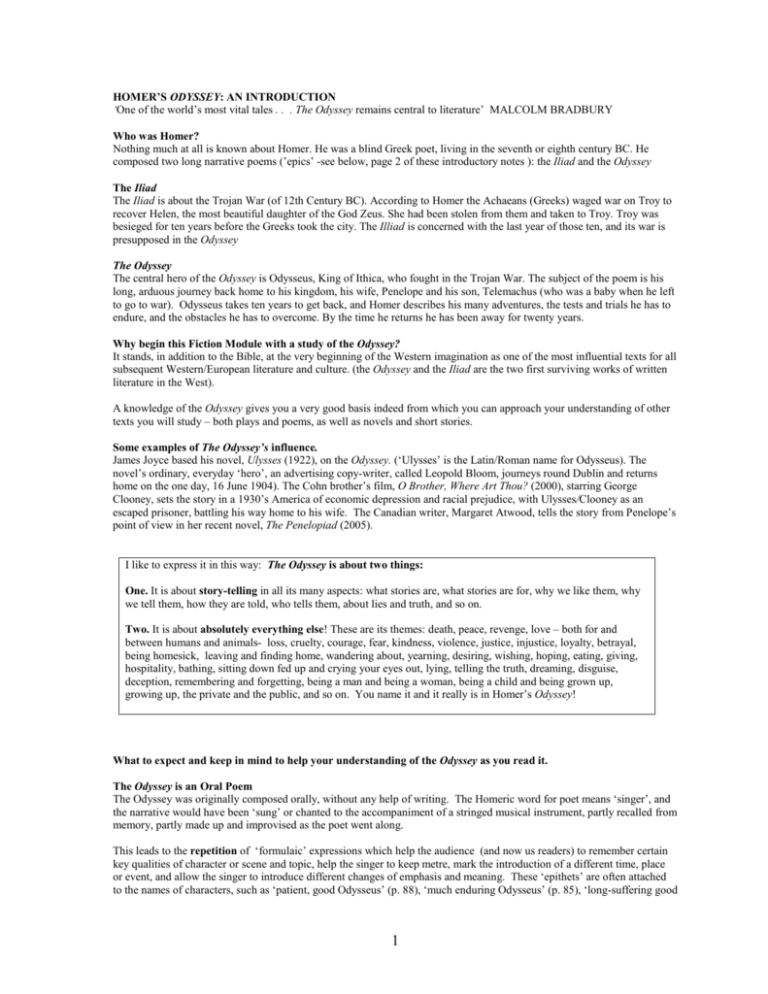
HOMER’S ODYSSEY: AN INTRODUCTION ‘One of the world’s most vital tales . . . The Odyssey remains central to literature’ MALCOLM BRADBURY Who was Homer? Nothing much at all is known about Homer. He was a blind Greek poet, living in the seventh or eighth century BC. He composed two long narrative poems (’epics’ -see below, page 2 of these introductory notes ): the Iliad and the Odyssey The Iliad The Iliad is about the Trojan War (of 12th Century BC). According to Homer the Achaeans (Greeks) waged war on Troy to recover Helen, the most beautiful daughter of the God Zeus. She had been stolen from them and taken to Troy. Troy was besieged for ten years before the Greeks took the city. The Illiad is concerned with the last year of those ten, and its war is presupposed in the Odyssey The Odyssey The central hero of the Odyssey is Odysseus, King of Ithica, who fought in the Trojan War. The subject of the poem is his long, arduous journey back home to his kingdom, his wife, Penelope and his son, Telemachus (who was a baby when he left to go to war). Odysseus takes ten years to get back, and Homer describes his many adventures, the tests and trials he has to endure, and the obstacles he has to overcome. By the time he returns he has been away for twenty years. Why begin this Fiction Module with a study of the Odyssey? It stands, in addition to the Bible, at the very beginning of the Western imagination as one of the most influential texts for all subsequent Western/European literature and culture. (the Odyssey and the Iliad are the two first surviving works of written literature in the West). A knowledge of the Odyssey gives you a very good basis indeed from which you can approach your understanding of other texts you will study – both plays and poems, as well as novels and short stories. Some examples of The Odyssey’s influence. James Joyce based his novel, Ulysses (1922), on the Odyssey. (‘Ulysses’ is the Latin/Roman name for Odysseus). The novel’s ordinary, everyday ‘hero’, an advertising copy-writer, called Leopold Bloom, journeys round Dublin and returns home on the one day, 16 June 1904). The Cohn brother’s film, O Brother, Where Art Thou? (2000), starring George Clooney, sets the story in a 1930’s America of economic depression and racial prejudice, with Ulysses/Clooney as an escaped prisoner, battling his way home to his wife. The Canadian writer, Margaret Atwood, tells the story from Penelope’s point of view in her recent novel, The Penelopiad (2005). I like to express it in this way: The Odyssey is about two things: One. It is about story-telling in all its many aspects: what stories are, what stories are for, why we like them, why we tell them, how they are told, who tells them, about lies and truth, and so on. Two. It is about absolutely everything else! These are its themes: death, peace, revenge, love – both for and between humans and animals- loss, cruelty, courage, fear, kindness, violence, justice, injustice, loyalty, betrayal, being homesick, leaving and finding home, wandering about, yearning, desiring, wishing, hoping, eating, giving, hospitality, bathing, sitting down fed up and crying your eyes out, lying, telling the truth, dreaming, disguise, deception, remembering and forgetting, being a man and being a woman, being a child and being grown up, growing up, the private and the public, and so on. You name it and it really is in Homer’s Odyssey! What to expect and keep in mind to help your understanding of the Odyssey as you read it. The Odyssey is an Oral Poem The Odyssey was originally composed orally, without any help of writing. The Homeric word for poet means ‘singer’, and the narrative would have been ‘sung’ or chanted to the accompaniment of a stringed musical instrument, partly recalled from memory, partly made up and improvised as the poet went along. This leads to the repetition of ‘formulaic’ expressions which help the audience (and now us readers) to remember certain key qualities of character or scene and topic, help the singer to keep metre, mark the introduction of a different time, place or event, and allow the singer to introduce different changes of emphasis and meaning. These ‘epithets’ are often attached to the names of characters, such as ‘patient, good Odysseus’ (p. 88), ‘much enduring Odysseus’ (p. 85), ‘long-suffering good 1 Odysseus’ (p. 93), ‘nimble-witted Odysseus’ (p. 98). You will notice, for example, how often dawn is referred to as ‘fresh and rosy-fingered’, and the sea as ‘wine dark’. It is very useful to make a note of these key epithets (with page number reference) under character and topic headings as they are repeated and altered. There are also repeated scenes, conventions, or rituals which have a particular structure and significance, but note how Homer often varies the detail. Examples can be found in the welcoming and entertaining of guests, the forms of hospitality, on the occasions of public story-telling. The Odyssey is an EPIC This means it is a long narrative on a serious subject. It is told in a formal structured style (see, for example, the comment on repetitions above). It is concerned with heroes and heroic deeds on which the fate of history, conflicts, whole countries, other people, and households may depend. The action is often in battles, tasks to be carried out, obstacles to be overcome, long and difficult journeys, quests. This all happens under the eyes of the gods who, in great contrast to the Christian God, intervene very directly in human affairs and have very human qualities, such as anger, and minds which can be changed. The events described come to have the importance of myth and legend through which countries and peoples define themselves and their history. Psychology and the Inner Life As Peter Jones writes in his introduction to our Penguin edition, ‘Homer’s world is one of speaking and doing’ (p. xl). We therefore enter a world where will, deed and -I would add- emotion (of gods and humans alike) are of first importance. Homer may not tell us much about motivation or the inner life, but both are nevertheless present and very important, and we can work out key features of psychology and the inner life from the way characters speak and behave both when they are alone (As when Telemachus observes that his mother says he is Odysseus’ son, but he himself cannot tell (p. 8), or when we see the ‘lion-hearted’, ‘valiant’ Odysseus sit disconsolate and weeping by the shore (pp. 65 and 67); or when they are interacting with each other, such as in the conversation between Nausicaa and Odysseus which takes place when she discovers him on the shore of her country (pp. 79 and 80). We must ourselves ask the text as to what is revealed of the thought and feeling behind the action, even though Homer may not directly tell us. Story within Story A most important feature of the Odyssey is the number of stories told in it. It has what we might call the structure of story within story. For example, it certainly is Homer who tells the story of the Odyssey but, very soon in Book 1, we are listening to Athene telling a (false) story to Telemachus. In Books 9, 10, 11, and 12, Odysseus tells his own story of his adventures. This follows Book 8, in which someone else –Demodocus- has just been telling stories about Odysseus. As we read we should be aware of and alert to the significance of who is telling the story, why, to whom, in what context. Note: Peter Jones has very helpfully set out the structure of the Odyssey on pp. xii-xviii of the Introduction. In Book 8 Demodocus tells the story of the adultery of the gods Ares and Aphrodite (p. 101), and then the story of the story of the Wooden Horse of Troy (p. 107). This in turn acts as the preface to Odysseus telling his own tale, the entirety of Books 9, 10, 11, and 12 (pp. 110-68). He has also provided some useful advice regarding how we should read Homer today on pp. xxxviii of his introduction. He has also provided a very useful Index and Glossary starting on p. 325 which means it is easy to look up key topics and characters –when they speak, what they do etc. A Reading Project The idea of a Hero/Heroine Before you start reading the Odyssey I would like you to think about the idea of a hero/heroine and make a few notes in just a paragraph. Do you have a hero or heroine? What makes them ‘heroic’? What is to be admired about them? Ask your parents and friends if they have a hero or heroine and why -or why not. You may end up with some contrasting or conflicting ideas –one friend’s hero/heroine is another friend’s villain, for example. (See Peter Jones’ comment in the Introduction to our edition pp. xliii - xliv). Remember that heroes can be real/historical (Columbus), and/or fictional (Shrek), and be either public or private/personal. The Odyssey has its main hero in Odysseus –he is the text’s centre of attention. But as you read it you discover that he is not entirely admirable, even though for Homer he is definitely ‘heroic’. The text also has other characters who can be admired – Odysseus’ wife, Penelope; his son, Telemachus; the loyal herdsman, Eumaeus –look at the footnote on page 182 of our edition. As you are reading think again about hero/heroine/role-model, and make some notes on how the text in fact may complicate our understanding of what a hero is. Such reading leads naturally also to thinking about villains –those who are set against our ‘hero’, in what ways they can be regarded as ‘bad’, and deserving of punishment. (Tutor: Raymond Salter) 2
